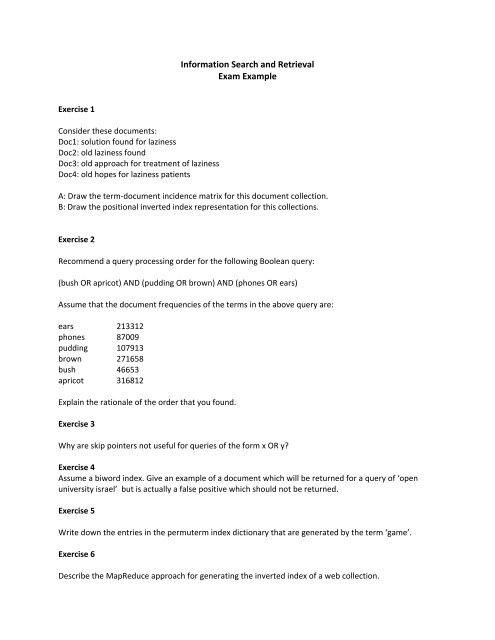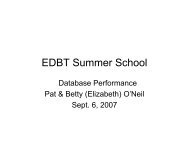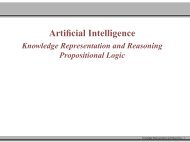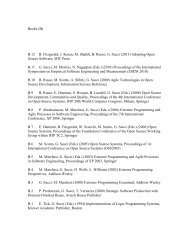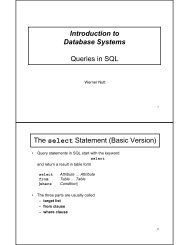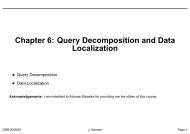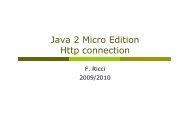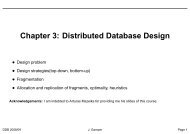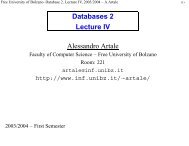Information Search and Retrieval Exam Example
Information Search and Retrieval Exam Example
Information Search and Retrieval Exam Example
Create successful ePaper yourself
Turn your PDF publications into a flip-book with our unique Google optimized e-Paper software.
Exercise 1<br />
Consider these documents:<br />
Doc1: solution found for laziness<br />
Doc2: old laziness found<br />
Doc3: old approach for treatment of laziness<br />
Doc4: old hopes for laziness patients<br />
<strong>Information</strong> <strong>Search</strong> <strong>and</strong> <strong>Retrieval</strong><br />
<strong>Exam</strong> <strong>Exam</strong>ple<br />
A: Draw the term‐document incidence matrix for this document collection.<br />
B: Draw the positional inverted index representation for this collections.<br />
Exercise 2<br />
Recommend a query processing order for the following Boolean query:<br />
(bush OR apricot) AND (pudding OR brown) AND (phones OR ears)<br />
Assume that the document frequencies of the terms in the above query are:<br />
ears 213312<br />
phones 87009<br />
pudding 107913<br />
brown 271658<br />
bush 46653<br />
apricot 316812<br />
Explain the rationale of the order that you found.<br />
Exercise 3<br />
Why are skip pointers not useful for queries of the form x OR y?<br />
Exercise 4<br />
Assume a biword index. Give an example of a document which will be returned for a query of ‘open<br />
university israel’ but is actually a false positive which should not be returned.<br />
Exercise 5<br />
Write down the entries in the permuterm index dictionary that are generated by the term ‘game’.<br />
Exercise 6<br />
Describe the MapReduce approach for generating the inverted index of a web collection.
Exercise 7<br />
Imagine to use Jaccard coefficients for computing a query document score: jaccard(Q,D) = |Q ∩ D| / |Q<br />
∪ D|, where Q <strong>and</strong> D represent the set of terms included in a query <strong>and</strong> a document. Let Q=’open<br />
source’. Identify a document D1 that is relevant for Q <strong>and</strong> a document D2 not relevant for Q such that<br />
jaccard(Q,D1) < jaccard(D,D2). This example should illustrate why jaccard is not suited to score<br />
documents.<br />
Exercise 8<br />
How does the base of the logarithm affect idf calculation?<br />
Exercise 9<br />
Compute the vector space similarity between the query “film cameras” <strong>and</strong> the document “film cameras<br />
<strong>and</strong> digital cameras”. Assume that the document frequencies of the terms film, camera <strong>and</strong> digital are:<br />
100, 300, 1,000. Assume the number of documents is N = 10,000, logarithmic term weighting for query<br />
<strong>and</strong> document, idf weighting for the query only <strong>and</strong> cosine normalization for the document only. Treat<br />
<strong>and</strong> as a stop word. What is the final similarity score?<br />
Exercise 10<br />
Consider an information need for which there are 4 relevant documents in the collection.<br />
Contrast two systems run on this collection. Their top 10 results are judged for relevance as follows (the<br />
leftmost item is the top ranked search result):<br />
System 1: R N R N N N N N R R<br />
System 2: N R N N R R R N N N<br />
a. What is the MAP (Mean Average Precision) of each system? Which has a higher MAP?<br />
b. Does this result intuitively make sense? What does it say about what is important in getting a good<br />
MAP score?<br />
c. What is the R‐precision of each system? (Does it rank the systems the same as MAP?)<br />
Exercise 11<br />
Consider the following training set<br />
D1: "American Boston American" ‐> Class=Y<br />
D2: "American American Chicago" ‐> Class=Y<br />
D3: "American Washington" ‐> Class=Y<br />
D4: "Rome Italy American" ‐> Class=N<br />
Estimate P(xk|cj) <strong>and</strong> P(cj) using the following formulas:<br />
| docs j |<br />
P(<br />
c j ) ←<br />
| total # documents |<br />
P(<br />
x<br />
k<br />
n jk + 1<br />
| c j ) ←<br />
n + | Vocabulary |<br />
j
Where: docsj is the subset of documents for which the target class is cj; xk in a word of the vocabulary;<br />
njk is the number of occurrences of xk in all the documents in class j, nj is the total number of words in<br />
the documents in class j.<br />
What is the predicted class of the following test document:<br />
D5: "American American American Rome Italy"<br />
Exercise 12<br />
Consider an item‐based Collaborative Filtering recommender system. If an active user u0 has rated four<br />
items (p1, p2, p3, p4) with ratings (1, 2, 4, 5) = (v01, v02, v03, v04) Assume further that there are two<br />
additional items p5 <strong>and</strong> p6, which has not been rated by u0, <strong>and</strong> the similarities of p5 <strong>and</strong> p6 with the<br />
items (p1, p2, p3, p4) are given by the following two vectors (0.8, 0.9, 0.7, 0.3) <strong>and</strong> (0.7, 0.4, 0.9, 0.9)<br />
respectively . If CF must recommend just one item, what should it be?<br />
Explain the rationale of the reply by computing the predicted rating for p5 <strong>and</strong> p6 as the weighted <strong>and</strong><br />
normalized average of the ratings of the products (p1, p2, p3, p4) (i.e., the usual formula for item‐based<br />
CF).<br />
Exercise 13<br />
Define the Mean Absolute Error, <strong>and</strong> compute it for a test set of 200 predictions where the system<br />
predicts in 60% of the cases a rating that is larger than the true rating by 1, in 30% a rating that is lower<br />
than the actual rating by 2, <strong>and</strong> in 10% of the cases the exact rating.


